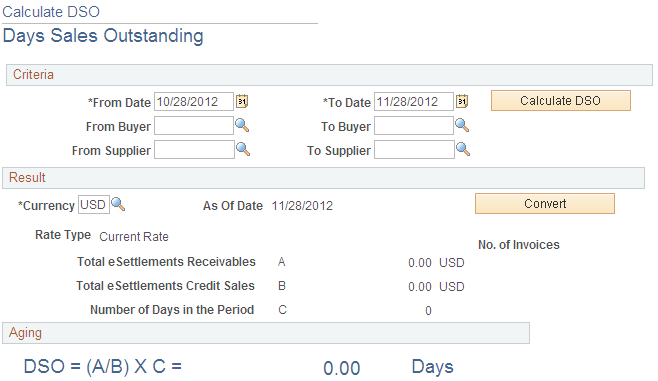Calculating Days Sales Outstanding (DSO)
This section provides an overview of days sales outstanding (DSO) and discusses how to calculate DSO.
|
Page Name |
Definition Name |
Usage |
|---|---|---|
|
EM_DSO |
Specify criteria to calculate a DSO value. |
The DSO financial indicator shows both the age in days of an organization's accounts receivables, and the average time it takes to turn those receivables into cash. The balance is expressed in terms of recent sales, and it is compared to industry and organization averages and standard selling terms.
Several methods exist for calculating DSO. The method discussed here follows the Dun and Bradstreet Receivables Management guidelines.
Regular DSO measures the time it takes to collect receivables. It reflects the organization's internal collection efficiencies, and it requires three pieces of information for calculation:
Total receivables for the period analyzed.
Total credit sales for the period analyzed.
The number of days in the period analyzed.
Here is the formula for the standard (regular) DSO calculation:
Here is an example scenario:
Total Receivables = 4,600,000 JPY.
Total Credit Sales = 9,000,000 JPY.
Number of days in period = 90.
Here is the calculation:
In this example, it takes 45 days (on the average) to collect the receivables.
Use the Calculate DSO - Days Sales Outstanding page (EM_DSO) to specify criteria to calculate a DSO value.
Navigation:
This example illustrates the fields and controls on the Calculate DSO - Days Sales Outstanding page. You can find definitions for the fields and controls later on this page.

Specify the criteria to have the system calculate the DSO. From and To dates are required.
Result
Field or Control |
Description |
|---|---|
Total eSettlements Receivables |
Displays the total of the unpaid invoices. |
Total eSettlements Credit Sales |
Displays the total of paid and unpaid invoices. |
Number of Days in the Period |
Displays the number of days between the from date and the to date selections (invoice date range). |